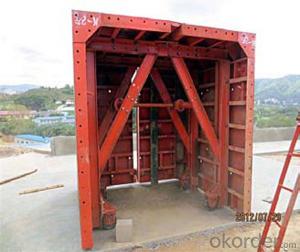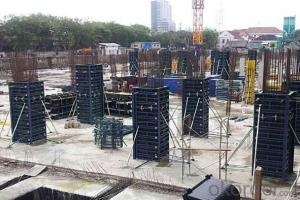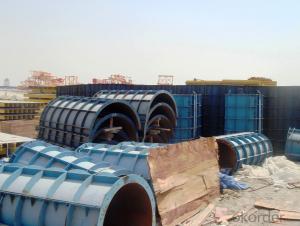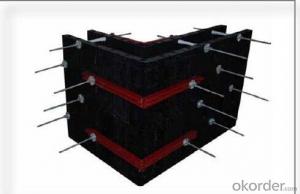Steel Formwork System Fromwork Accessories High Quality
- Loading Port:
- Tianjin
- Payment Terms:
- TT OR LC
- Min Order Qty:
- 25 m.t
- Supply Capability:
- 1000 m.t/month
OKorder Service Pledge
OKorder Financial Service
You Might Also Like
Steel Formwork System Fromwork Accessories High Quality
Product pictures:
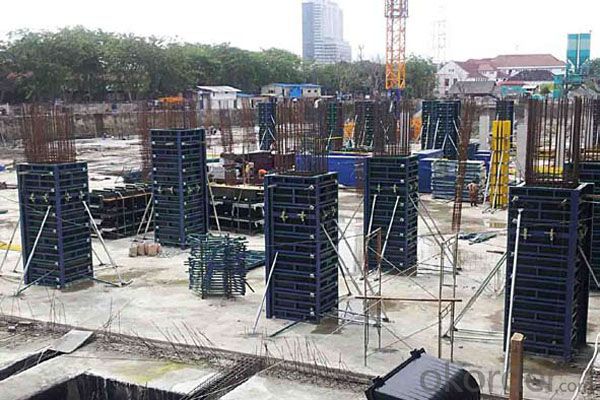
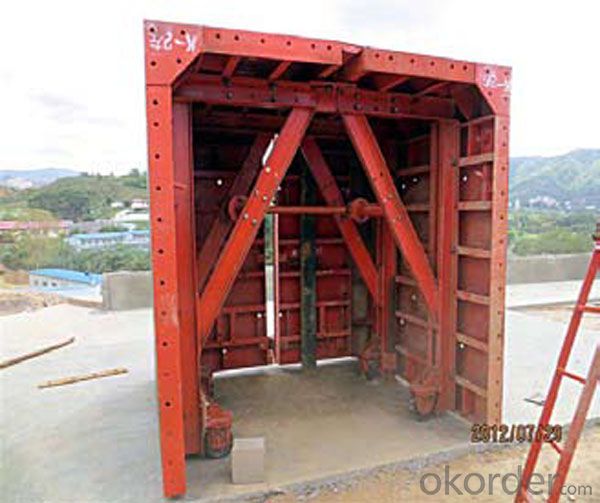
Product description:
Name: | RingLock Scaffold System |
Category: | Scaffolding System |
Material: | Steel (Q235/Q345) |
Size: | D48*3.25mm, etc |
Surface: | Electro Galvanized, Hot Dipped Galvanized, Painted, Powder Coated |
Component: | Standard, Ledger, Diagonal Brace, Bracket, Base Jack, U Head Jack, Etc. |
Application: | Slab Support, Staircase, Stage Plateforms, Bridge Support, Mobile Tower, etc. |
Manufacturer: | OEM is Available |
Items or goods can be manufactured according to your standards. | |
Advantage
* Good loading capacity
* Easy to assemble and dismantle
* Excellent quality for formwork & scaffolding with wide choices
Other scaffolding & formwork products:
(1) Scaffolding System:
(2) Scaffolding Frame & Accessories:
(3) Scaffolding Couplers/Clamps:
(4) Formwork System Scaffolding & Accessories:
Company introduce and advantages:
1. A state-owned company, prestige fi rst.
2. One of Fortune 500 companies in the world. No. 5 in the building material fi eld.
3. Six Sigma strategy , which means no more than 3.4 defects existing among one million of error
possibilities.
4. In line with the business, we launched E-business platform Okorder.com.
5. We are highly recognized by our business partners and clients all over the world and has obtained rapid
development under the spirit of win-win.
FAQ
Why Us?
We are one of the largest construction materials suppliers in China.
We own professional manufacturers with powerful producing capacity.
Extensive and comprehensive quality control system
Excellent products with competitive prices.
Efficient services in pre and after sale.
Full energy with affluent experience team.
- Q:Are there any limitations to using steel frame formwork?
- Yes, there are some limitations to using steel frame formwork. Firstly, steel frame formwork can be quite expensive compared to other types of formwork systems such as wood or aluminum. The initial investment cost for steel frame formwork can be higher, and it may not be feasible for small-scale or budget-conscious projects. Secondly, steel formwork is relatively heavy, which can make it difficult to handle and transport. This can lead to additional labor and equipment costs, as well as longer construction timelines. Additionally, steel formwork requires skilled labor for installation and dismantling. It is not as user-friendly as some other formwork systems, and workers need to have adequate training and experience to effectively and safely use steel formwork. Furthermore, steel formwork is not as versatile as other types of formwork systems. It may not be suitable for complex or irregular shapes and may require additional customization or modifications to adapt to specific project requirements. Lastly, steel formwork needs to be properly maintained and protected from rust and corrosion. Regular inspection and maintenance are necessary to ensure the longevity and structural integrity of the steel formwork, adding to the overall cost and effort associated with its usage. In summary, while steel frame formwork has its advantages, such as high strength and durability, there are limitations to its use, including high cost, heavy weight, requirement for skilled labor, limited versatility, and maintenance needs. These factors should be considered when deciding whether to utilize steel frame formwork for a construction project.
- Q:How does steel frame formwork contribute to faster construction times?
- Steel frame formwork contributes to faster construction times in several ways. Firstly, steel formwork is highly durable and can withstand the pressure and weight of concrete without warping or deforming. This means that it can be reused multiple times, reducing the time and effort required for formwork installation and removal. Additionally, steel frame formwork systems are designed to be easily assembled and disassembled, allowing for rapid construction and dismantling. The modular nature of these systems enables quick adjustments and modifications to the formwork configuration, saving time and ensuring accuracy. Furthermore, steel formwork provides a smooth and even surface finish, eliminating the need for additional plastering or finishing work. This saves both time and cost associated with the final touches of construction. Moreover, steel frame formwork allows for efficient pouring and curing of concrete. The tight joints and secure connections between the formwork elements ensure that the concrete is properly contained and shaped during the pouring process. This eliminates the need for additional support structures and minimizes the risk of concrete leakage or collapse. Overall, the strength, reusability, easy assembly, and efficient pouring capabilities of steel frame formwork contribute to faster construction times by reducing the labor and time required for formwork installation, providing a smooth surface finish, and facilitating rapid concrete pouring and curing processes.
- Q:How does steel frame formwork handle different types of cured concrete removal techniques?
- Steel frame formwork is designed to handle different types of cured concrete removal techniques effectively. The strong and durable steel frame provides stability and support during the removal process, ensuring that the formwork structure remains intact. Whether it involves using mechanical methods like jackhammers or chemical solutions for concrete dissolution, the steel frame formwork can withstand the forces and pressure exerted during the removal without compromising its structural integrity. Thus, steel frame formwork is well-equipped to handle various techniques for removing cured concrete efficiently and safely.
- Q:How does steel frame formwork ensure proper concrete consolidation and compaction?
- Steel frame formwork ensures proper concrete consolidation and compaction by providing a rigid structure that holds the concrete in place during the pouring and curing process. The steel frame acts as a support system, preventing the concrete from sagging or deforming under its own weight. This ensures that the concrete remains in the desired shape and form, allowing for effective consolidation and compaction. Additionally, the steel frame formwork allows for the use of vibration equipment, which helps to further consolidate the concrete, removing any air voids and ensuring uniform compaction throughout the structure. Overall, steel frame formwork plays a crucial role in maintaining the integrity and quality of the concrete during the construction process.
- Q:How does steel frame formwork prevent concrete shrinkage and cracking?
- Steel frame formwork prevents concrete shrinkage and cracking by providing strong support and reinforcement to the concrete structure. The steel frame acts as a rigid and stable framework, ensuring that the concrete remains in its intended shape during curing. This prevents excessive shrinkage and cracking that may occur due to internal stresses or inadequate support. Additionally, the steel frame formwork allows for proper alignment and placement of reinforcement bars, further increasing the strength and durability of the concrete structure.
- Q:Can steel frame formwork be used in extreme weather conditions?
- Yes, steel frame formwork can be used in extreme weather conditions. Steel is known for its durability and strength, which makes it suitable for withstanding harsh weather conditions such as extreme temperatures, heavy rainfall, strong winds, and even snow. Unlike other materials, steel frame formwork is less likely to warp, crack, or degrade when exposed to extreme weather conditions. Additionally, steel formwork systems are designed to be easily assembled and disassembled, allowing for quick and efficient construction projects even in challenging weather conditions. However, it is important to ensure that the steel frame formwork is properly coated and protected against corrosion to maintain its longevity and performance in extreme weather conditions.
- Q:How does steel frame formwork handle different types of formwork stripping equipment?
- Steel frame formwork is compatible with various types of formwork stripping equipment due to its strong and rigid structure. It can easily bear the weight and pressure exerted during the stripping process, ensuring stability and safety. Additionally, steel frame formwork allows for easy attachment and detachment of different types of stripping equipment, making it versatile and efficient in handling various formwork stripping techniques.
- Q:How does steel frame formwork handle the placement of embedded items and fixtures?
- Steel frame formwork is a versatile and efficient system used in construction projects to create concrete structures. When it comes to handling the placement of embedded items and fixtures, steel frame formwork offers several advantages. Firstly, steel frame formwork provides a high degree of flexibility and adaptability. The frames can be easily adjusted and modified to accommodate various embedded items and fixtures such as pipes, electrical conduits, and HVAC systems. This allows for precise positioning and integration of these elements within the concrete structure. Additionally, the steel frame formwork system is designed to support the weight of these embedded items and fixtures. The frames are made of robust steel sections that are capable of withstanding heavy loads, ensuring the stability and integrity of the formwork during the concrete pouring and curing process. Furthermore, steel frame formwork allows for efficient installation and removal of embedded items and fixtures. The formwork can be easily dismantled and reassembled, providing easy access for the installation of embedded items and fixtures. This saves time and effort during the construction process, as there is no need for additional formwork to be created or modified. Moreover, steel frame formwork ensures precise positioning and alignment of embedded items and fixtures. The frames are designed with accurate measurement systems, allowing for precise placement of these elements within the concrete structure. This helps to ensure that the final structure meets the required specifications and standards. Overall, steel frame formwork is an excellent choice for handling the placement of embedded items and fixtures in construction projects. Its flexibility, load-bearing capacity, ease of installation, and precision make it a reliable and efficient system for integrating these elements into concrete structures.
- Q:What are the main components of steel frame formwork?
- The primary elements of steel frame formwork are as follows: 1. Steel Frames: These serve as the fundamental components of steel frame formwork. They are crafted from top-notch steel and are engineered to provide stability and support while pouring concrete. The frames are typically modular and can be easily assembled and disassembled, making them incredibly versatile. 2. Plywood Panels: Plywood panels are utilized to construct the formwork surface onto which the concrete is poured. These panels are usually composed of high-quality plywood treated to be resistant to water and durable. The dimensions and thickness of the plywood panels may vary depending on the specific project requirements. 3. Tie Rods and Wing Nuts: Tie rods and wing nuts are employed to hold the steel frames together and ensure the stability of the formwork structure. The tie rods are threaded and can be adjusted to achieve the desired tension, while the wing nuts are used to secure the tie rods in place. 4. Adjustable Props: Adjustable props are employed to support the steel frame formwork and ensure that it maintains the correct position during the concrete pouring process. These props can be easily adjusted to the desired height and can withstand heavy loads. 5. Formwork Accessories: Various accessories such as clamps, connectors, and brackets are employed to connect and reinforce the steel frames. These accessories aid in ensuring the stability and integrity of the formwork structure. Overall, the primary components of steel frame formwork collaborate to create a robust and dependable system capable of supporting the weight of the concrete throughout the construction process. This type of formwork is widely utilized in the construction industry due to its durability, flexibility, and user-friendly nature.
- Q:Are there any limitations to the weight of concrete that can be poured with steel frame formwork?
- Yes, there are limitations to the weight of concrete that can be poured with steel frame formwork. The weight of concrete that can be poured with steel frame formwork depends on several factors, including the strength and stability of the steel frame, the design and dimensions of the formwork, and the capacity of the equipment used for pouring and distributing the concrete. Steel frame formwork is designed to withstand a certain amount of load, and exceeding this load limit can lead to structural failures or collapse. Therefore, it is essential to adhere to the manufacturer's recommendations and specifications for the maximum weight of concrete that can be poured with the specific steel frame formwork being used. Other limiting factors include the size and height of the formwork. Taller formwork structures may require additional support or reinforcement to handle the weight of the concrete. Additionally, the formwork design should consider the pressure exerted by the concrete during pouring and ensure that it can withstand these forces without deformation or failure. It is also crucial to consider the capacity of the equipment used for pouring and distributing the concrete. The equipment, such as concrete pumps or cranes, should have the necessary lifting capacity to handle the weight of the concrete being poured. Exceeding the lifting capacity of the equipment can result in accidents or damage to the steel frame formwork. In conclusion, there are limitations to the weight of concrete that can be poured with steel frame formwork. These limitations are influenced by factors such as the strength and stability of the steel frame, the design and dimensions of the formwork, and the capacity of the equipment used. It is essential to follow the manufacturer's guidelines and specifications to ensure the safe and successful pouring of concrete using steel frame formwork.
1. Manufacturer Overview |
|
|---|---|
| Location | |
| Year Established | |
| Annual Output Value | |
| Main Markets | |
| Company Certifications | |
2. Manufacturer Certificates |
|
|---|---|
| a) Certification Name | |
| Range | |
| Reference | |
| Validity Period | |
3. Manufacturer Capability |
|
|---|---|
| a)Trade Capacity | |
| Nearest Port | |
| Export Percentage | |
| No.of Employees in Trade Department | |
| Language Spoken: | |
| b)Factory Information | |
| Factory Size: | |
| No. of Production Lines | |
| Contract Manufacturing | |
| Product Price Range | |
Send your message to us
Steel Formwork System Fromwork Accessories High Quality
- Loading Port:
- Tianjin
- Payment Terms:
- TT OR LC
- Min Order Qty:
- 25 m.t
- Supply Capability:
- 1000 m.t/month
OKorder Service Pledge
OKorder Financial Service
Similar products
New products
Hot products
Related keywords

